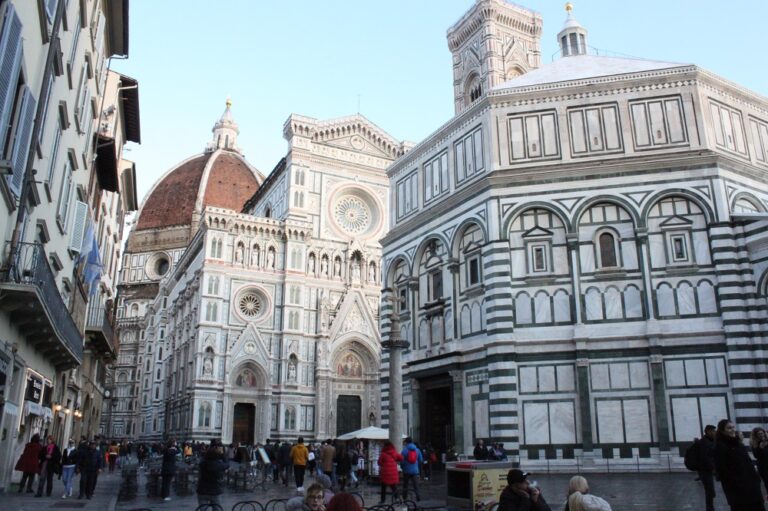The Duomo of Florence: A Timeless Masterpiece of Renaissance Architecture
The Duomo of Florence—formally the Cathedral of Santa Maria del Fiore—is far more than a religious monument. It’s a breathtaking symbol of human ingenuity, artistic brilliance, and Florentine pride. Rising above the city’s historic center, this architectural marvel draws millions of visitors each year. They come to witness the grandeur of one of the most iconic cathedrals in the world.
🏗️ A Century of Vision and Craftsmanship
Construction began in 1296 under the direction of Arnolfo di Cambio, a visionary of the Gothic era. Over the next 140 years, the cathedral evolved through changing styles and engineering breakthroughs. It was finally consecrated in 1436—a testament to patience, ambition, and artistry.
👷♂️ Architectural Geniuses Who Shaped the Duomo
Several great minds contributed to the cathedral’s creation:
- Arnolfo di Cambio laid the foundation with a bold Gothic design, aiming to rival Europe’s grandest cathedrals.
- Giotto, the famed painter, designed the adjacent Campanile in 1334, adding elegance and verticality.
- Filippo Brunelleschi revolutionized architecture with his daring dome—a feat that changed history.
🏛️ Brunelleschi’s Dome: A Renaissance Revolution
Brunelleschi’s dome remains the largest brick dome ever built. For nearly six centuries, it has stood as a marvel of engineering. His self-supporting design used no scaffolding—a technique that baffled his peers and still inspires awe today.
The dome features two shells supported by 24 stone ribs. Only eight are visible from the outside, creating a striking octagonal silhouette that defines Florence’s skyline.
🎨 The Facade: A Symphony in Marble
The cathedral’s exterior is a visual masterpiece. Polychrome marble panels in green, pink, and white create a vibrant, harmonious design. Completed in the 19th century by Emilio De Fabris, the Neo-Gothic facade honors the cathedral’s medieval roots while adding romantic flair.
🌟 Interior: Grandeur in Silence
Step inside and discover a serene, spacious interior. The nave stretches over 153 meters, ranking among Europe’s largest. Though relatively austere, the space holds treasures: stained-glass windows, Renaissance frescoes, and statues by masters like Vasari and Zuccari. Their Last Judgment scene on the dome adds drama and depth.
🗼 Giotto’s Campanile: A Tower of Elegance
Beside the cathedral stands Giotto’s Campanile, reaching 84.7 meters into the sky. Designed in 1334, it’s admired for its geometric precision and colorful marble cladding. Sculptural reliefs depict biblical scenes and human history. Climb its 414 steps for breathtaking views of Florence.
🚪 The Baptistery of St. John: Gates of Paradise
Completing the Piazza del Duomo is the Baptistery of San Giovanni—one of Florence’s oldest buildings. Its bronze doors, especially the Gates of Paradise by Lorenzo Ghiberti, are masterpieces of Renaissance sculpture. Inside, the octagonal shape and gold mosaic ceiling evoke sacred beauty and historical depth.
✨ Why Visit the Duomo of Florence?
Whether you’re an architecture lover, a history enthusiast, or a curious traveler, the Duomo offers an unforgettable experience. From Brunelleschi’s dome to Giotto’s tower, every detail tells a story of ambition, innovation, and artistic triumph.
It’s no surprise the Florence Cathedral is a UNESCO World Heritage Site—and a cornerstone of Florentine identity.

